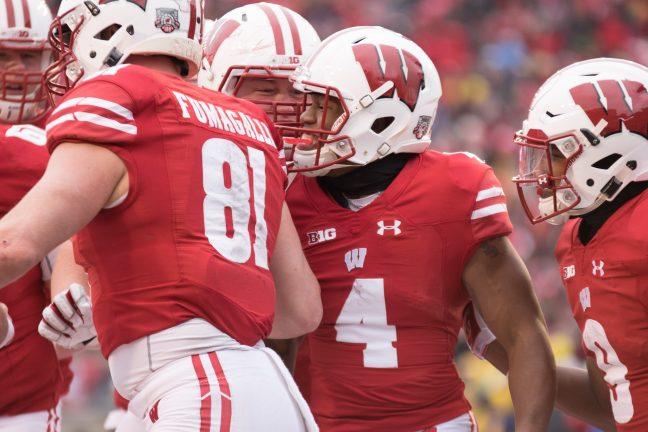Wisconsin wide receiver A.J. Taylor arrived on campus with a big role to play within the Badgers’ offense. Taylor stepped foot in Madison as a rare four-star wide receiver recruit for an offense that has traditionally relied on classic Big Ten ground-and-pound offense.
In fact, it had been close to a decade since the Badgers acquired a versatile threat like Taylor. Prior to his commitment, the last time Wisconsin nabbed a four-star wide receiver was with Kraig Appleton in their 2009 recruiting class.
Taylor’s dual-threat nature of both rushing and receiving was put to use as soon as he stepped on the field for the Badgers in his freshman year. While Taylor played in just five games that first year, he caught three passes for an average gain of 17.7 yards and also ran the ball four times for a total of 19 yards.
This would be just the beginning of Taylor’s contributions to the Wisconsin offense that, as shown by the stats, was desperately needed to keep the Badger offense alive.
After his introductory freshman year, Taylor truly had a breakout season during his second year of competition. In 14 games played, Taylor received the ball 31 times for a total of 475 yards. He also found the end zone five times, averaging a touchdown about one out of every six receptions.
Football: Last year’s top receivers return as quarterback battle rages on
No matter how strong the offensive performance from Taylor, there was no way he would be able to make up the difference in passing yards lost from before his arrival. Instead, the Wisconsin offense fell further and further into its run-centric offensive strategy.
In 2015, the year before Taylor’s arrival, the Badgers threw for an average of nearly 230 pass yards per game. In 2016, that average fell to under 180 yards per game. With Taylor’s breakout season, as well as the arrival of Danny Davis, the second consecutive four-star WR to commit to Madison, the 2017 season saw small improvements with 192 yards of passing averaged per game.
These two wide receivers accounted for a large portion of the receiving numbers in 2017. The only two players who ranked above them in receiving yards for the season were Quintez Cephus and Troy Fumagalli, both of whom would be absent from the squad the next year.
2017 was a strong year for Taylor in which he could serve as a strong wide receiver for a team that had plenty of options for Alex Hornibrook to target. In 2018, he would have to lead the team in order to ensure that an air attack still existed for the Badgers.
Taylor led the team in games played, total receiving yards, average yards per reception for those who had over five receptions on the season, average yards per reception and had the longest reception of the year at 44 yards.
In 2018, the Badgers put on an absolutely dismal display nearly every time they put the ball in the hands of either Jack Coan or Hornibrook. They averaged just 158 passing yards per game, their lowest average since 2014, a year in which that low total was offset by averaging just over 320 rush yards per game.
Football: AJ Taylor’s unexpected season as No. 1 receiving option
Even with Taylor’s best season yet up to that point, the Badgers still put on their worst passing performance in years. It’s hard to imagine what the season might have looked like without his performances. Would Jonathan Taylor have gotten even more carries? Would Danny Davis have been able to step up and play a more senior role for the offense?
It’s tough to tell for sure, but the fact that AJ Taylor is playing less of a role this season could speak to the fact that the Badger offense has found more balance, not that his ability to perform is dropping.
Through seven games, Taylor has caught a total of 16 passes from Coan. This is certainly on pace to match his reception totals from 2017 and 2018, but his average yards per catch dropped significantly. Taylor is currently averaging just 9.9 yards per catch, compared to his 2017 and 2018 averages of 15.3 and 16.3 yards, respectively.
Cephus and Jake Ferguson currently both outrank Taylor in total yards receiving and average yards per catch. This isn’t a sign that Taylor is being beat out for a limited number of receiving opportunities. Instead, Coan is simply doing a better job of spreading the ball around when a pass play is dialed up.
Football: The meteoric rise of Badgers quarterback Jack Coan
Furthermore, the return of Cephus — the Badgers’ top receiver in 2017 — was bound to cut into the receiving stats of Taylor. Not to mention, Jonathan Taylor markedly improved his receiving abilities heading into 2019, offering himself as a great backfield check-down opportunity when things get sketchy for Coan.
Taylor served as a clutch receiver when the offense needed him most. Without Taylor in 2018, the Badgers could have slipped even further into one-dimensionality as both Hornibrook and eventually Coan struggled to find their footing.
Now, with the return of Cephus, the improvement of Jonathan Taylor and the refinement of Jack Coan, Taylor no longer has to play such a large role in the offense in order to be successful. While his stat line may not currently reflect it, Taylor is still the receiver that has the ability to lead the Badger offense.


